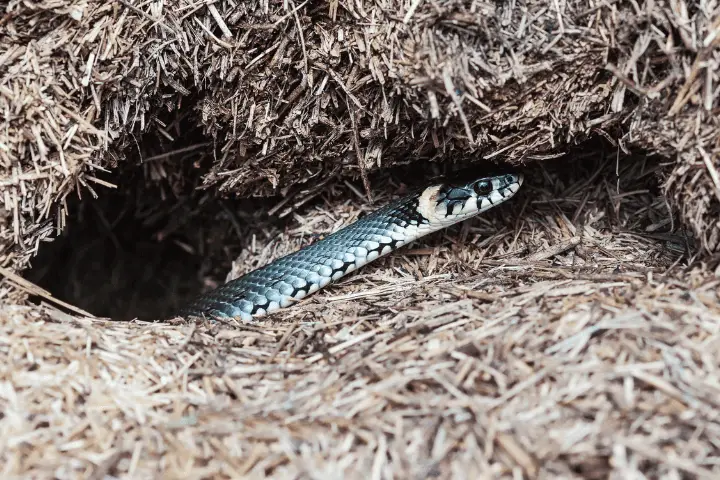Can Snakes Dig Holes
Snakes have slithery, flexible bodies and they’ve always fascinated us.
Can they really dig holes? Let’s find out!
Some species, like the North American rattlesnake and the African mole snake, have special adaptations to help them dig in various types of soil.
They use several methods to create their underground homes. They press against the ground with their strong bodies, pushing aside soil and forming tunnels.
They also use their scales and curved snouts to aid in digging.
This ability has many uses. Burrows provide shelter and protection from predators and bad weather.
Plus, they can be used for hibernation and shedding. For egg-laying species, the burrows are a safe place to incubate.
So iff you want to observe snakes in the wild or keep them as pets, you need to create a suitable hole-digging environment.
Put loose substrate materials like sand or peat moss in their enclosure so they can burrow.
Also, make sure the humidity is right. Snakes need moisture for healthy shedding and overall well-being, so provide a shallow water dish.
Snakes may not have shovels, but they know how to dig a hole and bury the competition!
What is snake digging?
Snakes dig for a variety of purposes. They lack limbs and claws, so they use strong muscles and scales on their undersides to push and lift dirt.
This takes immense strength and agility.
These burrows offer safety from predators and protection from extreme weather. They also provide an ideal environment for hibernating.
Plus, they help with hunting. Some snakes create shallow tunnels near water sources to ambush prey.
Studying snake digging allows us to understand the behavior and adaptations of these creatures.
It helps us appreciate how diverse species survive in challenging environments.
But why do snakes dig? They know that, when life gives you dirt, you make tunnels!
Why do snakes dig holes?
Why do snakes dig holes? It’s all about protection and shelter.
They may live in forests, grasslands, or deserts, but some environments don’t offer good hiding spots or safety from predators.
So, snakes use their bodies to wiggle and wriggle underground to make their own shelters.
The caves also keep them safe from extreme temperatures. Plus, they can hide from threats and predators.
Trees and nests are no use for snakes, so they’ve adapted by burrowing. The tunnels give them a secure place to spot prey.
Digging also helps with hunting. Snakes use ambush tactics, so they can hide underground and wait for prey to pass by. If you find a snake hole near you, don’t disturb it.
To coexist, avoid leaving piles of rocks or debris that could be hideouts. Keep your yard tidy with trimmed grass and cleared vegetation.
If you see a snake in an area where it doesn’t belong, contact a wildlife or pest control agency.
Don’t try to capture it yourself – it’s dangerous without the right knowledge.
How do snakes dig holes?
Snakes are unique creatures, able to dig holes without limbs. Here’s how they do it!
Step 1: Prep. Snakes survey the area to find a spot with loose soil or sand. Ideally, they prefer damp environments.
Step 2: Get digging! They use their sharp snouts and powerful jaws to create tunnels. They do this by pushing forward in a wave-like motion.
Step 3: Shovels. Snakes use their scales as makeshift shovels. This helps them push against the soil and move further down. Plus, the scales protect them from rough terrain.
Step 4: Hiding. To cover up the hole, snakes reverse out in a backward wave-like motion. This smooths out the soil, leaving no trace of their work.
Some snakes even make elaborate chambers in their burrows. These provide shelter and a place to hibernate.
Where do snakes dig holes?
Snakes are incredible creatures of the wild. They can adapt to their surroundings in many ways. One of them is by digging holes.
They can select different locations for burrowing, like soft soil, sand, or loose debris. Or, they may opt for natural crevices and abandoned animal burrows.
Snakes are very versatile. They can be seen creating burrows in forests, grasslands, deserts, and even rocky terrains. Each species may have its own preference, depending on factors like temperature, moisture levels, and availability of prey.
For instance, desert-dwelling sidewinder rattlesnakes dig curved burrows in the sand to stay cool.
Some snake species even have the ability to create complex underground networks. They use techniques like pressing their bodies against the soil and pushing backwards to excavate tunnels.
This allows them to make chambers for resting and hibernation.
In ancient civilizations, snakes symbolized wisdom and rebirth. They were present in various myths and beliefs. Many species were viewed as protectors or symbols of fertility due to their connection with underground realms.
Digging holes might be the only workout snakes are willing to do, since they don’t have arms.
Benefits of snake digging
Snakes can dig, and it has many benefits!
First, they create secure homes, protecting them from danger and bad weather.
Second, they help soil aeration and nutrient cycling, which helps plants grow.
Third, they hunt rodents in their burrows.
Additionally, snakes bury seeds in the ground, helping plants grow again.
Moreover, they aid in decomposition of organic matter with soil microorganisms.
Finally, they make depressions that collect rainwater, which is a great water source for other animals in dry climates.
Explorers have been fascinated by snake digging since 1839, when Charles Darwin encountered a python digging in the Malay Archipelago!
It showed us these reptiles’ amazing abilities and started us thinking about their behaviors and adaptations.
Be careful around snake holes! They could be a portal to the secret underground of Death and Slitheriness!
Risks and dangers associated with snake holes
Snake holes come with risks and dangers for humans and animals. Venomous snakes can bite, and the narrow and dark holes can lead to falls and injuries.
Plus, other creatures like spiders and scorpions may be breeding there. Snake behavior can be unpredictable, making navigation near them tricky.
Unknowingly stepping on a snake hole can startle the snake, leading to defensive attacks. And, in regions with venomous species like rattlesnakes or cobras, the risks are even higher.
Some snakes even build underground tunnel systems that may collapse. Tales from ancient cultures remind us of the perils associated with snake holes.
It’s essential to be vigilant when encountering these treacherous dwellings. The potential hiding places for poisonous snakes and other hazardous creatures, as well as physical risks like structural collapses, cannot be overlooked.
Knowing the hazards is key to staying safe in areas with these reptiles’ underground habitats.
So, while snakes may not be able to dig holes, they certainly know how to slither their way into our hearts…and nightmares.
Conclusion
Snakes have the ability to dig holes!
Specialized scales and strong muscles help them burrow in various soils. Some species have been seen using their bodies to push aside dirt and vegetation for makeshift hiding places.
This challenges the idea that snakes always use pre-made holes for shelter and shows their adaptability.
Studies show snake burrowing has multiple purposes. Protection from predators and weather, mating, hibernating, and raising young are all possible.
Digging allows snakes to have a safe and private environment.
Not all snakes do extensive burrowing.
Factors such as habitat, body size, and ecological niche determine how much they dig. Some prefer using existing crevices or structures rather than digging their own burrows.

